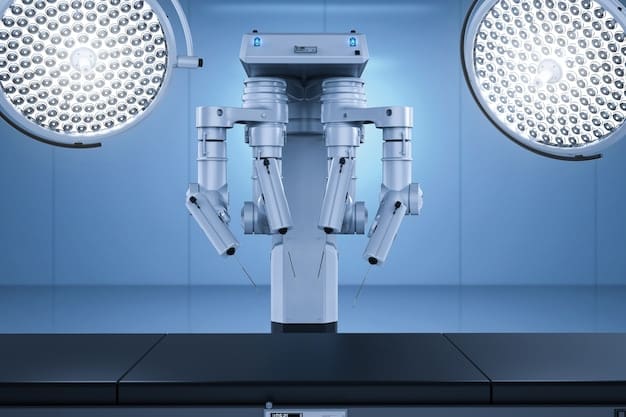Technology in Medical Dramas: Accuracy vs. Hollywood Hype

The role of technology in medical dramas is pivotal, evolving from simple pagers to advanced AI, but the accuracy of these depictions often diverges significantly from real-world medical practices.
Medical dramas have long captivated audiences with their high-stakes scenarios, complex characters, and, increasingly, their portrayals of medical technology. But how accurately do these shows reflect the realities of modern medicine? The role of technology in medical dramas: From pagers to AI, a look at accuracy reveals a complex relationship between entertainment and reality.
The Evolution of Medical Technology on Screen
From the early days of television, medical dramas have used technology to add realism and drama to their storylines. The accuracy, however, has always been a point of contention. Here’s a look at how medical technology has evolved on screen.
Pagers: The Early Days of Connectivity
Before smartphones and instant communication, pagers were the lifeline for doctors on call. Their depiction in early medical dramas was often accurate, showing the urgency and immediate response required in emergency situations.
The Rise of Diagnostic Machines
As technology advanced, so did its portrayal in medical dramas. MRI machines, CT scanners, and other diagnostic tools became central to storylines, often used to uncover rare and complex conditions.

Here are some key technological milestones frequently depicted:
- X-rays: Basic but essential, often shown for quick diagnoses.
- EKGs: Monitoring heart activity, a staple in emergency room scenes.
- Defibrillators: Used to dramatically revive patients in critical condition.
The evolution on screen mirrors the real-world changes in medical practice, but the drama often comes at the expense of accuracy. The focus shifts towards the visual impact and narrative tension rather than the technical details.
The Accuracy of AI in Medical Dramas
Artificial intelligence (AI) is increasingly becoming a part of medical dramas, offering a glimpse into a future where machines assist in diagnosis and treatment. However, the realities of AI in medicine are often exaggerated for dramatic effect.
AI as a Diagnostic Tool
Many medical dramas portray AI as being able to instantly diagnose rare and complex conditions with near-perfect accuracy. While AI is being developed for diagnostic purposes, it is far from being as advanced as depicted on screen.
Robotic Surgery
Robotic surgery is another area where medical dramas often take liberties. The precision and capabilities of robotic surgical systems are often overstated, presenting a highly idealized view of their potential.

Here’s a closer look at the accuracy:
- Speed of Diagnosis: AI rarely provides instant solutions in reality.
- Integration with Systems: Seamless data flow is more fiction than fact.
- Ethical Considerations: The dilemmas of AI bias are often overlooked.
While AI holds immense promise for the future of medicine, its portrayal in medical dramas often leans more towards science fiction than reality. The ethical and practical challenges of implementing AI in healthcare are often glossed over for the sake of drama.
Common Technological Misconceptions in Medical Dramas
Medical dramas often perpetuate several misconceptions about medical technology. These inaccuracies, while adding to the drama, can misinform viewers about the realities of modern medicine.
Instantaneous Results
One of the most common inaccuracies is the speed at which test results are returned. In reality, many tests take hours or even days to process, but in dramas, the results often appear within minutes.
Overreliance on Technology
Medical dramas sometimes portray doctors as being overly reliant on technology, neglecting basic clinical skills. In reality, experienced physicians rely on a combination of technology and traditional examination techniques.
Cybersecurity Risks
A pivotal point here is that medical dramas often neglect the cybersecurity aspects of medical technology. The risk of hacking and data breaches remains largely unexplored, even though it is a prevalent concern in hospitals.
Let’s explore the following:
- The “Magic Bullet” Device: A single device that solves every problem.
- Perfect Accuracy: Erroneous belief in infallible technology.
- Ignoring Human Error: Dismissing the role of user error.
By understanding these common misconceptions, viewers can approach medical dramas with a more critical eye, recognizing the difference between entertainment and reality. This awareness helps in forming more realistic expectations about medical technology.
The Impact of Medical Dramas on Public Perception
Medical dramas have a significant impact on public perception of medicine and technology. These shows shape viewers’ understanding of medical procedures, technologies, and the roles of healthcare professionals.
Shaping Expectations
The often-glamorized portrayal of medical technology can lead to unrealistic expectations about what modern medicine can achieve. Viewers may expect instant solutions and perfect outcomes, which can be frustrating when faced with real-world limitations.
Influencing Medical Knowledge
While medical dramas can raise awareness of certain medical conditions and technologies, they can also spread misinformation. Viewers might misinterpret simplified or dramatized scenarios as accurate representations of medical practice.
The “CSI Effect” in Medicine
Just as crime dramas can influence jury expectations in forensic science, medical dramas could potentially give rise to unrealistic expectations about medical evidence and diagnostics.
Consider these points:
- Increased Awareness: Highlighting rare conditions.
- Misinformation: Simplifying complex medical procedures.
- Changing Expectations: Quick fixes versus long-term care.
By presenting a balanced view of medical technology, medical dramas can contribute positively to public understanding and engagement with healthcare issues. However, it is crucial to recognize the potential for misinformation and unrealistic expectations.
Balancing Drama with Realism: A Producer’s Perspective
Creating a successful medical drama requires a delicate balance between dramatic storytelling and realistic portrayals of medicine. Here’s how producers navigate this challenge.
Consulting Medical Experts
Many medical dramas employ medical consultants to ensure accuracy in their storylines. These experts provide guidance on medical procedures, terminology, and the overall portrayal of healthcare settings.
Prioritizing Storytelling
Despite the input from medical consultants, producers often prioritize storytelling over perfect accuracy. Dramatic twists and emotional arcs are essential for engaging viewers, even if they require bending the truth.
Responsible Representation
Some producers recognize the importance of responsible representation, striving to balance entertainment with accurate and informative content. This can involve addressing ethical dilemmas and highlighting the complexities of modern medicine.
Here is what is taken into account:
- Accuracy vs. Narrative: The eternal struggle.
- Ethical Considerations: Balancing entertainment with responsibility.
- Education Through Entertainment: Informing while entertaining.
Ultimately, the goal is to create compelling television that resonates with audiences while also respecting the integrity of the medical profession. Striking the right balance between drama and realism is key to achieving this goal.
The Future of Technology in Medical Dramas
As technology continues to advance, its role in medical dramas will only become more prominent. Here’s a look at what the future might hold.
Virtual Reality (VR) and Augmented Reality (AR)
VR and AR could become integral to medical training and patient education. Medical dramas may start showcasing augmented reality to depict real-time data overlays during surgeries or consultations, enhancing the realism of these scenarios.
Telemedicine and Remote Monitoring
Telemedicine and remote monitoring are already transforming healthcare delivery. Medical dramas could explore the challenges and opportunities of providing care to patients in remote areas using advanced communication technologies.
CRISPR and Gene Editing
CRISPR and other gene-editing technologies are at the forefront of medical innovation. Medical dramas could delve into the ethical implications and potential benefits of these powerful tools.
Expect to see:
- Nanotechnology: Microscopic medical interventions.
- Bioprinting: Creating organs and tissues.
- Personalized Medicine: Tailoring treatments to individual genetic profiles.
The ever-evolving landscape of medical technology offers endless possibilities for storytelling, but it also requires a commitment to responsible and accurate representation. As medical dramas continue to push the boundaries of entertainment, they must also strive to inform and educate viewers about the realities and possibilities of modern medicine.
| Key Point | Brief Description |
|---|---|
| 📱 Pagers | Early connectivity for doctors on call. |
| 🤖 AI | Often over-exaggerated diagnostic tool. |
| 🔬 Misconceptions | Instant results and overreliance are common. |
| 🎬 Producers | Balance drama with realism using experts. |
Frequently Asked Questions
▼
The accuracy varies widely. While some shows consult medical experts, dramatic needs often lead to exaggerations or simplifications of medical technology and procedures.
▼
Common inaccuracies include overly fast test results, the belief that technology is always accurate, and neglecting the complexity of treatment options and cybersecurity risks.
▼
Yes, these dramas can shape public expectations, sometimes leading to unrealistic beliefs about what medical technology can achieve and influencing perceptions of healthcare practices.
▼
Producers often consult medical experts to advise on accuracy, but storytelling priorities can take precedence. The balance is finding gripping narratives that respect the field of medicine.
▼
Future dramas likely feature VR, AR, telemedicine and gene-editing tech. These will offer new storytelling avenues and more realistic portrayals of medical innovations and their ethical implications.
Conclusion
Medical dramas will continue to evolve alongside medical technology, offering viewers a glimpse into the exciting, and sometimes frightening, future of healthcare. By understanding the balance of drama and realism, viewers can engage with these shows critically and appreciate the complexities of modern medicine.





